

|
| Elliott Sound Products | Project 97 |
 Main Index Main Index
 Projects Index Projects Index
|
 Please Note: PCBs are available for this project. Click the image for details.
Please Note: PCBs are available for this project. Click the image for details.A complete hi-fi preamp including tone controls (and with provision for PCB mounted pots) is something I have avoided, since the pots that are available in different parts of the world are not necessarily compatible. Due to demand, this project has been developed (along with a complete PCB) to fill the gap in the lineup available from ESP.
The preamp featured is very straightforward to make on the PCB, and has an innovative tone defeat function. Rather than completely disable the tone controls, they are massively de-sensitised, and when 'defeated' have a maximum range as shown in Fig. 3 (below). This can be increased if desired, so you can have two tone control settings, one with the normal 10dB boost and cut, and the other with a very subtle 3dB boost and cut - this will be enough (surprisingly) for very minor adjustments such as you might need for day-to-day listening.
Otherwise, the design is fairly conventional, with the main advantage over other designs being that there are almost no wires to run. Source switching is done any way you like - I suggest a rotary switch at the rear of the enclosure, and an extension shaft to bring the shaft to the front. This results in the minimum of wiring, and reduces crosstalk from other active inputs.

As you can see, the PCB is very compact. The volume pot is actually spaced a little further apart than the others to allow a larger knob, since this is the most commonly used control in any preamp. The use of 16mm pots makes for a small and neat layout, and makes it very easy to include the preamp with a power amp, making a complete integrated amplifier system.
Note that the Rev-A board is slightly different from the Rev - circuitry shown here. The differences are not great, but you do need the info in the secure site to see where the various parts are located.
The input stage is configured as shown with a gain of 2 (6dB), and also acts as a buffer for the tone control circuit. The tone control is a basic Baxandall type, but the addition of R116, 117 and 118 provide flexibility and easy reconfiguration that is not available with the traditional arrangement.
R116 is the tricky part in this circuit (which is unique, by the way - I have not seen this technique used before). As shown it is 100k, and this limits the tone control range to a sensible ±10dB. To obtain more boost and cut, R116 (and R216) may be omitted altogether. Conversely, reducing the value will give a smaller range, with about 6dB at 20Hz, and 7.5dB at 20kHz with 22k.
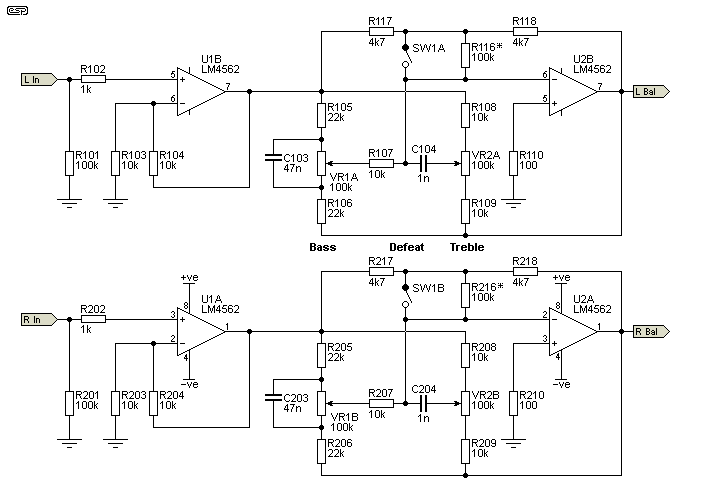
The tone control (and overall) performance is shown in Figure 2 (10% steps of the pots), and it can be seen that the midrange is barely affected. This is in contrast to the majority of designs, where the controls are centred on 1kHz, and there is a very audible effect in the midrange frequencies. For those who absolutely do not want to use tone controls, I suggest the DoZ preamp (Project 37) or Project 88 - both were designed with no tone controls and are more in the line of true minimalist designs.
Some constructors may have difficulties finding 100k dual linear pots. If this applies to you, then a different value can be used. For example, if you can get 50k dual pots, just double the tone control capacitor values (Cx03 and Cx04), and halve the resistor values (Rx05 - Rx09). This will maintain the same performance. The same basic principle applied for any pot value, with the lower limit being 10k - any less may cause excessive opamp loading (caps are ×10, resistors divided by 10). With 10k pots, I suggest that Rx17/18 are 1k, and Rx16 22k, and lower values for these resistors aren't recommended.
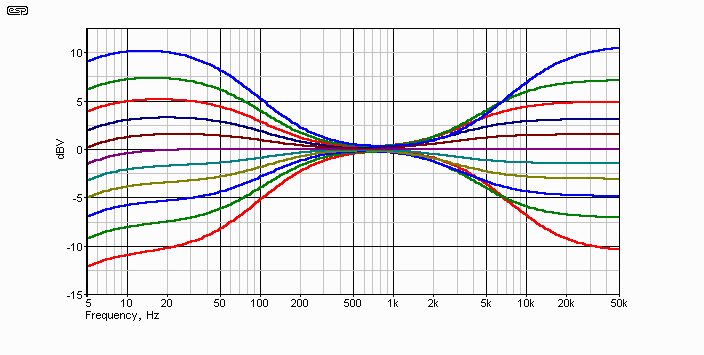
By contrast, Figure 3 shows the tone control range when SW1 is closed. This also means that when the controls are centred, any minor deviation (due to pot tolerances) is minimal, and response is completely flat (within 0.1dB). As you can see, the variation is much smaller, and it is probable that this setting will be the only one used most of the time.
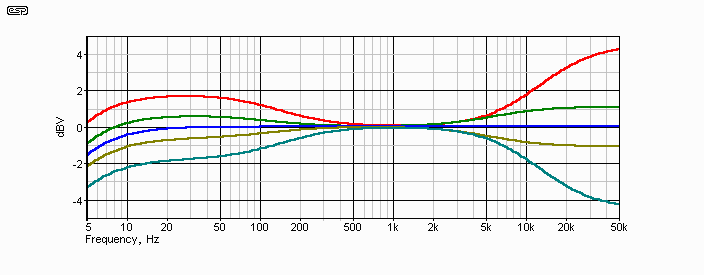
In Figure 3, the curves are shown for maximum, 75%, 50% 25% and minimum settings of the tone controls. The treble response is more pronounced than bass, but is still limited to a maximum of ±3dB at 20kHz. Overall, The circuit has excellent flexibility, and will suit normal 'rumpus room' duties just as readily as it will suit the listening room. Balance, volume and output stages are shown below ...
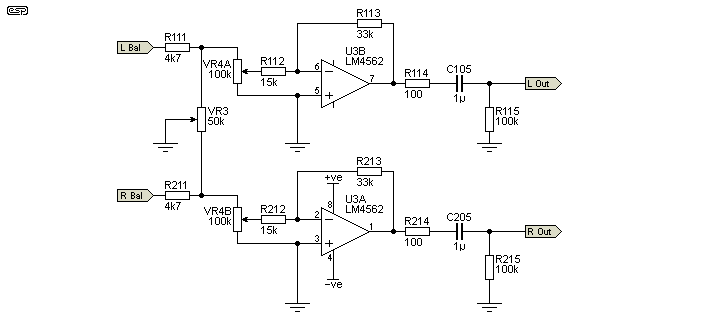
The balance control is deliberately designed to have very little effect around the central position, as this makes precise positioning much easier. The volume control uses a linear pot and a modified version of Project 01 'Better Volume Control' to obtain a log response. Output impedance is 100 ohms, and using the suggested 2.2µF polyester cap, the preamp will drive a 22k load with overall response as shown in figures 2 and 3. Low frequency cutoff is about 3Hz with a nominal 22k load. A higher value may be used for C103/203 if desired, but it is expected that the value shown will be quite sufficient for all normal power amplifiers. A polarised electro can be used and polarity is unimportant because there's only a few mV of DC at worst. I suggest a 10µF cap if you use an electro.
As with the tone controls, different value pots can be used here as well. The same basic criteria apply, so if the pot values are halved, then resistor values are also halved. You will need to be particularly careful though, because if the pot values are reduced too far, you will have difficulties due to low impedance loading on the tone control opamp (U2). This may cause the opamp to clip prematurely if the values are reduced too far.
The final stage is inverting - this is to correct for the inversion in the tone controls, and brings the overall phase back to normal. Again, this stage runs with a nominal gain of 6dB, although this varies as the volume pot is adjusted. Lowest noise is obtained at a middle setting of VR4 - the general area where the pot will be used the most.
The gain of the final stage depends on the setting of the volume and balance controls (it wouldn't be much use if that weren't the case  ), and with the balance control centred, the gain is -8dB (VR4 at 25%), -3.6dB (50%), 1dB (75%) and 9dB (100%). To determine the total gain, add the gain of the input stage (6dB as shown). The overall system gain (input and output gain stages) is around 2.6dB when the volume pot is centred.
), and with the balance control centred, the gain is -8dB (VR4 at 25%), -3.6dB (50%), 1dB (75%) and 9dB (100%). To determine the total gain, add the gain of the input stage (6dB as shown). The overall system gain (input and output gain stages) is around 2.6dB when the volume pot is centred.
If it is found that the gain is excessive (or insufficient), R113/213 can be reduced (or increased) in value - with 15k resistors, gain of this stage will be reduced to unity at maximum volume (probably too low), and a sensible compromise might be 22k. It depends on the input sensitivity of the power amplifier of course, so this is left up to the reader to determine after some initial tests. There is provision for PCB pins for R113/213 to allow you to change the resistors without needing access to the rear of the board.
The final figure shows the opamp bypass components - ceramic 100nF caps and 10µF electros are used for RF stability as usual. These are essential, and especially so where high speed opamps are used.

Electros should be rated at 50V minimum, as should the ceramics. Multilayer ceramic (aka 'monolithic') bypass caps are essential here, do not use polyester bypass caps, as their HF performance is simply not good as ceramics. They may be satisfactory for use with TL072 opamps, but ceramics are better.
Note that although shown using LM4562 opamps, NE5532, OPA2134 or anything else that suits your purposes may be used instead. TL072s are a good budget option, but I do not recommend using anything less than a TL072, even for the workshop or rumpus room, as there may be excessive noise - this in turn limits the usefulness of the preamp. Another good budget opamp is the MC/RC4558 or the MC/RC4580, both of which are actually much better than their price might indicate.
 |
The standard pinout for a dual opamp is shown on the left. If the opamps are installed backwards, they will almost certainly fail, so
be careful when installing them. The suggested opamps are very high performance, but if you prefer to use lower noise or wider bandwidth devices, that choice is yours. |
Remember that the supply earth (ground) must be connected! When powering up for the first time, use 100 ohm 'safety' resistors in series with each supply to limit the current if you have made a mistake in the wiring.
If the PCB is used, construction is a snap. As usual, all construction notes, Bill of Materials and recommended layouts are available on ESP's secure site. If you choose not to use the PCB, wiring is a little more challenging, since there are quite a few parts, and some wiring routing is reasonably critical if excessive crosstalk and oscillation is to be avoided.
All resistors should be metal film, and preferably 1% tolerance for best channel matching and noise performance. Likewise, the capacitors for the tone controls should be matched as closely as possible, using a capacitance meter. The pots are all linear, and for the PCB you will need PCB mount 16mm diameter pots - these are reasonably common everywhere.
Power requirements are not critical, but the P05 power supply is recommended to maintain low noise. Power should be ±12 to ±15V, with the higher voltage giving the best headroom. As shown, it will be difficult for any standard input signal to clip the input or tone control stages.
Finally, Figure 6 shows a fairly typical input switching system - nothing flash, but very functional. As mentioned above, a rotary switch at the rear of the case is recommended to minimise wiring and to make assembly as simple as possible. This is easily accomplished with the ESP 'ES-250' extension shaft (it's shown in the pricelist). The output labelled 'Record Out' can be connected to any recording device that can handle an input voltage of up to 2V RMS as may be provided from the other sources. If the phono preamp is used, be aware that the recorder must have a high input impedance. Anything less than 50k may cause unacceptable frequency response variations.
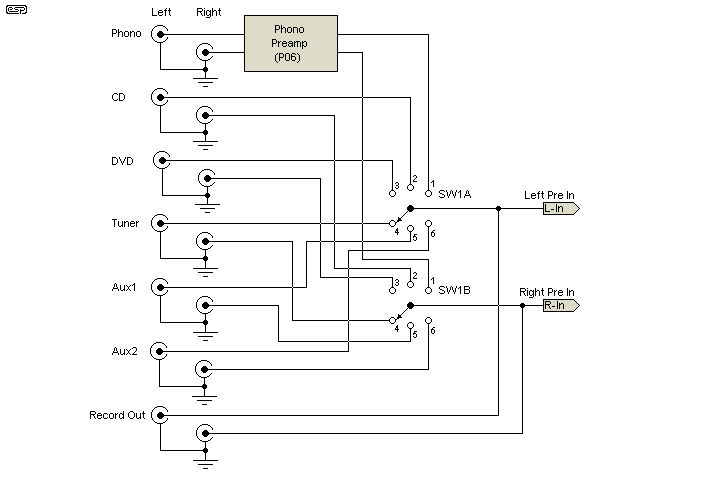
Any of the additional inputs (or the tape outputs) can be omitted if not needed, but since dual (stereo) rotary switches are typically 6 position, it makes sense to use all positions if possible. For the relatively small cost of the extra RCA connectors, you will have enough inputs to allow for future additions to your system. The phono preamp is naturally optional - there is no reason to include it if you don't have a turntable or any vinyl discs in your collection.
 Main Index Main Index
 Projects Index Projects Index
|